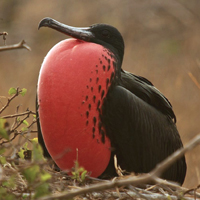Potential threats facing a globally important population of the magnificent frigatebird Fregata magnificens

All claims expressed in this article are solely those of the authors and do not necessarily represent those of their affiliated organizations, or those of the publisher, the editors and the reviewers. Any product that may be evaluated in this article or claim that may be made by its manufacturer is not guaranteed or endorsed by the publisher.
Tracking of seabirds has been used to identify foraging hotspots, migratory routes and to assess at-sea threats facing populations. One such threat is the potential negative interaction between seabirds and fisheries through incidental by-catch. In 2012, 60 magnificent frigatebirds Fregata magnificens were found dead, entangled in fishing line, at the globally important breeding site in the British Virgin Islands (BVI). To assess the potential relationship between foraging behaviour and fishing activity, data loggers were deployed on breeding magnificent frigatebirds to record foraging movements. In addition, a survey of local fishers was conducted to assess the scale of incidental by-catch. We recorded 28 complete foraging trips from GPS and GPS-GSM loggers, and 1758 PTT locations. Birds travelled up to 3.3–1067 km from their breeding colony and entered the waters of 10 neighbouring territories. A high percentage of fishers (93% = 28) reported catching at least one seabird annually, of which the most common were magnificent frigatebirds and brown boobies Sula leucogaster. There are estimated to be at least 1112 vessels in the recreational and artisanal fishing fleets of BVI and its neighbouring islands. Thus, this substantial fishery may have potentially profound effects on seabird populations in the region.
PAGEPress has chosen to apply the Creative Commons Attribution NonCommercial 4.0 International License (CC BY-NC 4.0) to all manuscripts to be published.

